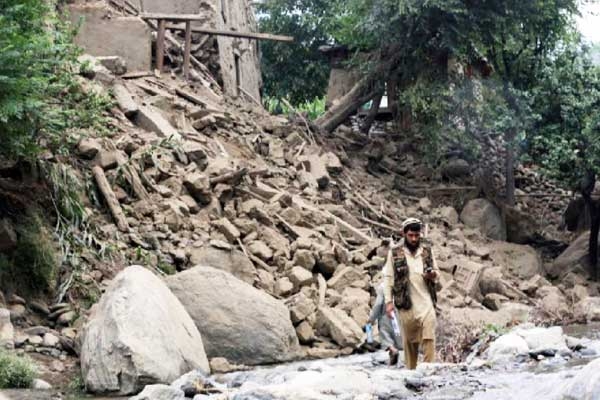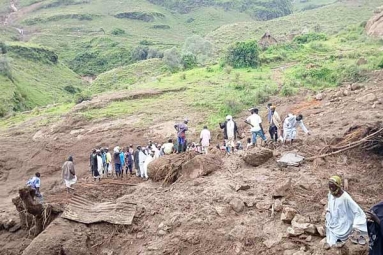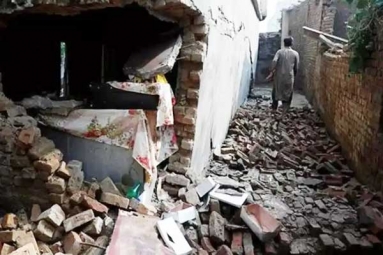
(Image source from: AP)
A strong earthquake hit eastern Afghanistan over the weekend, resulting in the deaths of over 1,400 people and leaving around 3,000 others injured, according to a statement from the Taliban government on Tuesday. This earthquake is considered one of the deadliest events in the country in many years. The number of casualties has been increasing since a 6.0-magnitude quake occurred late Sunday night, causing widespread destruction in remote, mountainous regions close to the Pakistani border.
The main spokesperson for the Taliban government, Zabihullah Mujahid, mentioned on X on Tuesday that 1,411 people lost their lives and 3,124 were injured in the severely affected Kunar province alone. An additional group of fatalities occurred in the neighboring Nangarhar province, where another dozen lives were lost, and hundreds sustained injuries.
The United Nations humanitarian coordinator in Afghanistan, Indrika Ratwatte, warned that the disaster could affect "hundreds of thousands" of people. Rescue teams continued their search for survivors amidst the collapsed buildings in Kunar on Tuesday. Ehsanullah Ehsan, who leads the Kunar Provincial Disaster Management Authority, informed AFP that emergency efforts lasted all night. He stated there were still injured individuals in remote villages who needed to be taken to hospitals. Local villagers assisted in the rescue mission by using their hands to remove debris from the mud and stone structures situated in steep valleys. Obaidullah Stoman, 26, who went to the village of Wadir looking for a friend, was struck by the extent of the destruction. "I'm looking here, but I haven't found him. It was really hard for me to witness the situation here," he shared with AFP. "Only rubble remains." The deceased, including children, were covered in white cloth by villagers who prayed for them before laying them to rest.
Some of the villages that suffered the most are still unreachable due to blocked roads, as reported by the UN migration agency to AFP. The US Geological Survey noted that the earthquake's epicenter was approximately 27 kilometers (17 miles) from Jalalabad and occurred just eight kilometers beneath the Earth's surface. Such shallow quakes tend to cause more destruction, especially since many Afghans live in low, mud-brick homes that are likely to collapse. After years of conflict, Afghanistan is among the poorest countries globally, dealing with a long-lasting humanitarian crisis along with the return of millions of Afghans who have been pushed back to their homeland by neighboring Pakistan and Iran recently.
Since the Taliban took control in 2021, aid from outside countries to Afghanistan has dramatically decreased, making it even harder for the struggling nation to deal with emergencies. The United States was the top donor until early 2025, when nearly all support was stopped after President Donald Trump came into office. In June, the United Nations announced that it would significantly cut back its worldwide humanitarian efforts because of "the largest funding cuts ever." On Monday, UN Secretary-General Antonio Guterres stated that the organization was collaborating with officials to "quickly evaluate needs, offer urgent help, and be prepared to rally more support," and he revealed an initial contribution of $5 million.
Many residents of the villages that experienced the earthquake are part of the over four million Afghans who have come back from Iran and Pakistan in recent times. Injured people were transported by helicopters from the secluded village of Wadir in Nurgal district to hospitals in the closest city, Jalalabad. Fourteen-year-old Akhlaq suffered injuries and was taken to the hospital, but five of his family members lost their lives when the earthquake hit Nurgal. "Our entire home fell down, and my brothers and father were all trapped. I was the only one who escaped," he recounted to AFP. "Then I heard my dad's voice, and I was able to help him.""There are people who are still beneath the debris, but no one is available to help them and get them out." Afghanistan often experiences earthquakes, particularly in the Hindu Kush mountain range, where the Eurasia and India tectonic plates meet.
In October 2023, a powerful 6.3-magnitude earthquake struck western Herat province, resulting in the deaths of over 1,500 individuals and damaging or demolishing more than 63,000 homes. A 5.9-magnitude earthquake hit the eastern province of Paktika in June 2022, claiming more than 1,000 lives and leaving tens of thousands without homes.









